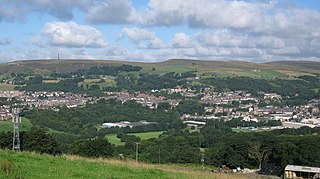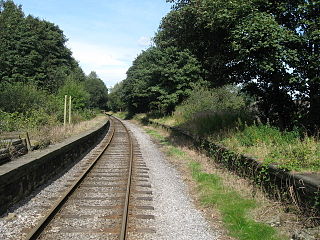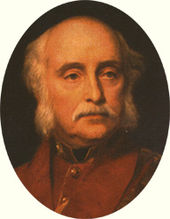
The East Lancashire Railway is a twelve-and-a-half-mile (20 km) heritage railway line in North West England which runs between Heywood, Greater Manchester and Rawtenstall in Lancashire. There are intermediate stations at Bury Bolton Street, Burrs Country Park, Summerseat and Ramsbottom, with the line crossing the border into Rossendale serving Irwell Vale and Rawtenstall. Before closure, the line terminated at Bacup.

Rossendale is a local government district with borough status in Lancashire, England. Its council is based in Bacup and its largest town is Rawtenstall. It also includes the towns of Haslingden and Whitworth. The borough is named after the Rossendale Valley, the upper part of the River Irwell.

Ramsbottom is a market town in the Metropolitan Borough of Bury, Greater Manchester, England. The population at the 2011 census was 17,872.
The East Lancashire Railway operated from 1844 to 1859 in the historic county of Lancashire, England. It began as a railway from Clifton via Bury to Rawtenstall, and during its short life grew into a complex network of lines connecting towns and cities including Liverpool, Manchester, Salford, Preston, Burnley and Blackburn.

The Rossendale Valley is in the Rossendale area of Lancashire, England, between the West Pennine Moors and the main range of the Pennines. The area includes the steep-sided valleys of the River Irwell and its tributaries, which flow southwards into Greater Manchester. The rivers cut through the moorland of the Rossendale Hills, generally characterized by open unwooded land, despite the ancient designation of "forest".

Stubbins is an industrial village in the southern part of the Rossendale Valley, Lancashire, England.

Rawtenstall is a town in the borough of Rossendale, Lancashire, England. The town lies 15 miles north of Manchester, 22 miles east of Preston and 45 miles south east of Lancaster. The town is at the centre of the Rossendale Valley. It had a population of 23,000.

Clifton railway station is a railway station in Clifton, Greater Manchester, England which was formerly called Clifton Junction. It lies on the Manchester–Preston line.

Clifton is a suburb of Swinton in the City of Salford in Greater Manchester, England. It lies along the edge of Irwell Valley in the north of the City of Salford. Historically in Lancashire, it was a centre for coal mining, and once formed part of the Municipal Borough of Swinton and Pendlebury.

Bury Bolton Street railway station is a heritage railway station in Bury, Greater Manchester, England. Located on the East Lancashire Railway.

Rosso (Rossendale Transport Limited) is a bus operator providing local services in Greater Manchester, Lancashire and West Yorkshire, England. It is a subsidiary of Transdev Blazefield, which operates bus services across Greater Manchester, Lancashire, North Yorkshire and West Yorkshire.

Ramsbottom railway station is a heritage station serving the town of Ramsbottom in Greater Manchester, England.
Clifton Viaduct is a Grade II listed stone structure crossing the valley of the River Irwell in Clifton, Greater Manchester, and also the Manchester, Bolton and Bury Canal. It is known locally as the "13 Arches". It is currently disused and closed to the public.

Outwood Viaduct is a Grade II listed railway viaduct crossing the River Irwell in Radcliffe, Greater Manchester. Following a period of disuse, it was restored and opened to the general public as a footpath.
Radcliffe Bridge railway station was a Railway Station in Radcliffe built on the Manchester, Bury and Rossendale Railway line, between Bury and Clifton, both in Greater Manchester. It was opened on 25 September 1846, and was closed 7 July 1958.

Stubbins railway station served the village of Stubbins, Rossendale, Lancashire, England. Opened by the East Lancashire Railway in 1847 on their line from Bury Bolton Street into Rossendale, it was situated next to the junction of the lines toward Accrington and to Rawtenstall and Bacup, but only had platforms on the latter route.
Molyneux Brow railway station was a railway station built on the Manchester, Bury and Rossendale Railway line, between Radcliffe and Clifton, in Greater Manchester.

The Manchester and Bolton Railway was a railway in the historic county of Lancashire, England, connecting Salford to Bolton. It was built by the proprietors of the Manchester, Bolton and Bury Canal Navigation and Railway Company who had in 1831 converted from a canal company. The 10-mile (16 km) long railway was originally to have built upon most of the line of the canal, but it was eventually built alongside the Salford and Bolton arms of the canal. The Act of Parliament also allowed the construction of a connection to Bury, but technical constraints meant that it was never built.















